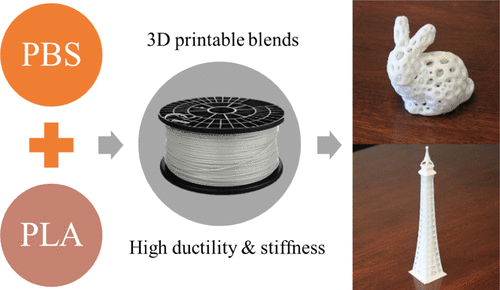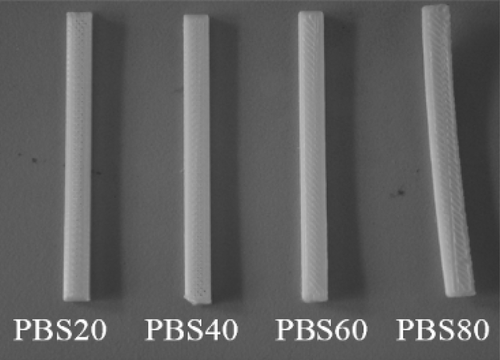Blending PLA and PBS Creates a Better 3D Printer Filament
In a paper entitled “Preparation and Characterization of Poly(butylene succinate)/Polylactide Blends for Fused Deposition Modeling 3D Printing,” a group of researchers discusses how they developed a new type of biodegradable material with high strength and toughness to be used for FDM 3D printing. A series of poly(butylene succinate) (PBS)-based polymer materials was blended with PLA. PLA, while a popular and effective 3D printing material, is brittle with extremely low elongation at break, so it is necessary to develop better, more ductile materials. PBS is a semicrystalline aliphatic polymer with excellent processability, thermal stability and biodegradability. It is also highly ductile and has a relatively low melting point.
“However, there are few published studies on 3D printing with PBS.” the researchers point out. “One reason is that its low melt strength makes it difficult to continually form monofilament when extruded, which makes printing fail halfway. Moreover, the distortion caused by the relatively large volume shrinkage during cooling probably happens after crystallization, thus resulting in defective products. Therefore, modification of PBS is quite necessary to solve the drawbacks mentioned above and make the material suitable for FDM printing.”
Blending the two materials can combine their advantages and compensate for their weaknesses. The researchers prepared PBS/PLA blends with different compositions with the intention of validating their suitability for 3D printing. The rheological, thermal and mechanical properties of the blends were investigated, and different specimens were 3D printed with the filaments to evaluate their suitability for FDM 3D printing technology. Interlayer bond strength in the 3D printed specimens was also evaluated.
All of the blends, according to the researchers, demonstrated excellent processing properties and can be extruded as 1.75 diameter monofilaments.
“With increasing PBS content, the elongation at break and impact strength of the blends arise,” they continue. “However, distortion of the printed bars increases due to larger volume shrinkage resulting from the higher degree of crystallinity in the blends. In addition, the interlayer bond strength improves due to the decreased melt viscosity. When PLA content in the blends is not less than 40 wt %, FDM printing can proceed smoothly with neither observable distortion nor detachment from the platform at room temperature. PBS60/PLA40 and PBS40/PLA60 are the optimal blend compositions, considering both material toughness, distortion of printed bars, and interlayer bond strength.”
Models with porous structures can be successfully 3D printed using PBS60/PLA40 and PBS40/PLA60 filaments, and good dimensional accuracy and glossy appearance of the printed structures was obtained. The blends proved themselves to possess both high stiffness and excellent ductility compared with commercial 3D printing materials.
“Moreover, with a relatively low printing temperature and no need for heating of the support platform, these materials appeal for meeting energy-saving and environmentally friendly requirements,” the researchers conclude. “Therefore, with pearl-like gloss and good mechanical properties as well as dimensional accuracy, the bio-based PBS/PLA blends are new promising materials for producing FDM filaments for applications in many fields, especially for architectural design. Furthermore, our study is expected to provide methods for evaluating whether a thermoplastic polymer material is suitable for FDM printing or not.”
Authors of the paper include Qing Ou-Yang, Baohua Guo and Jun Xu.
Discuss this and other 3D printing topics at 3DPrintBoard.com or share your thoughts below.
Subscribe to Our Email Newsletter
Stay up-to-date on all the latest news from the 3D printing industry and receive information and offers from third party vendors.
Print Services
You May Also Like
New Business: Temporary, Migratory, & Modular 3D Printed Architecture
If we look at potentially emerging 3D printing businesses, then architecture has not been fully explored. Yes, there is a lot of house 3D printing going on worldwide. From deployable...
3D Printing News Briefs, April 19, 2025: Material Extrusion Standard, Metal Powder, & More
In today’s 3D Printing News Briefs, we’re covering a proposed standard for material extrusion, before moving on to business and metal powder. We’ll end with a commercial store’s robotic 3D...
Japan Unveils World’s First 3D Printed Train Station
Japan is now home to what we believe is the world’s first train station built with 3D printing technology. Located in Arida City, just south of Osaka, the new Hatsushima...
restor3d Raises $38M to Expand 3D Printed Orthopedic Implants
Backed by $38 million in new funding, restor3d is pushing ahead with the launch of four personalized implant lines, set to roll out in 2025 and 2026. This latest venture...




























